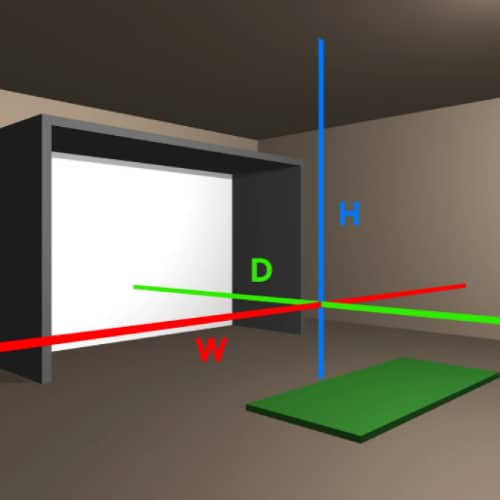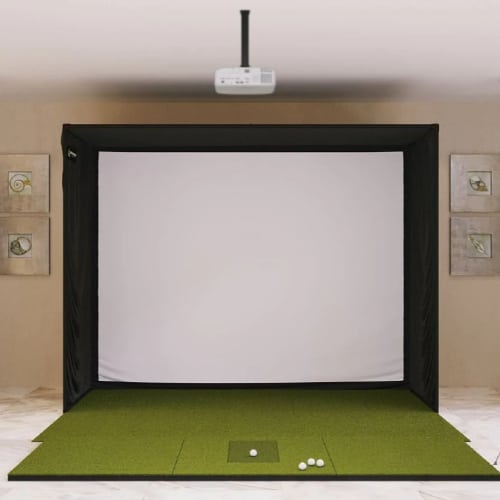If you want to set up a golf simulator system but are not sure of the optimal placement and design to maximize aesthetics and performance, then you’ve come to the right place.
Whether you’re dreaming of a minimalist golf simulator oasis or a high-tech training room with all the bells and whistles, the following article, with design inspiration tips and ideas, highlights what to consider in planning your own ideal golf simulator room setup.
In addition, we will provide answers to the most frequently asked questions related to the topic to ensure you learn everything you need to maximize the space use, comfort and looks of your new system.
Planning Your Golf Simulator Room
Transforming any interior room into an immersive golfing space or constructing a purpose-built backyard golf cabana requires careful planning. Key considerations include physical space needs, location factors and selecting the simulator equipment that best fits your budget. Learn more about how to build your own golf simulator here.
Space Requirements

While some basic simulator packages can work in a space as small as 10′ W x 12′ L, allowance for a full swing generally needs a minimum of 12′ W x 15′ L.
Optimal dimensions are 15′ x 18′ or larger to accommodate longer clubs as well as room for lounge seating. The ceiling height should be at least 8 to 10 feet for indoor setups.
Location Factors
Converting existing spaces like a basement rec room, detached garage or garden outbuilding can save on construction costs. Key considerations are power supply, climate control, ventilation and lighting needs, so keep those in mind.
Outdoor backyard cabanas also offer great golf season options but require weather and temperature management systems.
The choice of your simulator location will affect the initial investment.
Golf Simulator Equipment
One major choice is opting for an all-in-one packaged system or mixing and matching separate launch monitor, screen/netting and simulation software elements.

Leading home-use brands include OptiShot, SkyTrak, Foresight Sports, Full Swing, and About Golf. Entry-level packages start under $2,000, with high-end systems costing over $15,000 or more. Premium systems from HD Golf, Trackman and the like can cost upwards of $70,000.
Golf Simulator Room Design Ideas
When planning your dream home golf simulator space, it helps to have some inspiring design concepts in mind to guide layout and equipment decisions.
Here are 4 distinctive motif ideas for an indoor area tailored to different needs and budgets.
Minimalist Design
The essence of golf is player versus the course, so a basic simulator room showcases only the essential tech for that authentic virtual playing experience.
This pared-down style features a central impact screen or enclosure netting, basic mat or turf, smoothed concrete flooring, and ambient task lighting – clean and distraction-free.
Entertainment Room Style

For recreational enjoyment with friends, a lounge-style simulator room offers plush seating, a bar area with a mini-fridge and display shelving for collectibles. Lively graphics, vintage course photos and a striking focal wall visually carry the fun-zone motif.
Upscale gear like a large-screen TV, premium sound system and special effects lighting add to the appeal. The social simulator room easily transitions to big game viewing, movie nights or video gaming.
Professional Training Room
Avid golfers prioritizing skill-building and realistic simulation over decorative frills will appreciate an indoor training studio with high-end launch monitor analytics.
Quality hitting mats emulate actual turf interaction for authentic practice. Pro shop style fixtures and neutral colors promote focused concentration rather than visual distractions.
Additional gear enhances the functional training room motif – swing recording cameras, adjustable nets, chipping targets and sand bins help ingrain proper technique.
Backyard Golf Cabana
Constructing an insulated, detached outbuilding in your recreational space allows enjoying simulator golf outdoors during nice weather. Essential elements are retractable glass garage doors that connect the hitting station to a viewing patio/deck.
The compact yet comfortable interior can feature virtual golf components, informal seating, a beverage center or mini-kitchen, plus memorabilia displays themes to your favorite course.
Key Components of a Golf Sim Room
Successfully transforming any blank interior space into an immersive golfing area requires bringing together high-performance simulator components into a unified whole. These key tech elements combine to render a realistic virtual playing experience.
Hitting Area: Mats, Nets and Impact Screen

Quality hitting mats realistically simulate the feel of striking shots off actual grass turf for authentic practice.
Enclosure netting properly contains your shots within the room space. Tensioned impact screens display the simulated course imagery.
Key variables are materials and construction quality – from basic polyester to ultra-realistic micro-invariant fiber options that emulate grass interaction.
Display – Screen & Projector

Factors in choosing an optimal visual display are screen size, maximum resolution quality, positioning for ideal viewing angle, image brightness, and contrast. Full high-definition 1080p is viable, but 4K Ultra HD resolution is recommended for improved realism.
Projectors offer the largest display size – with some portable models providing up to over 200 inches. However, some prefer ultra HD smart TV screens from 75 to 85+ inches, especially for a lower-end sim package.
Central alignment allows a clear view from the hitting area. If for some reason, you can’t center the placement of your projector, make sure it has keystone adjustment so that the image is not distorted, regardless of where you position the projector.
Launch Monitor Technology

Advanced launch monitors precisely track every club and ball metric via radar or high-speed camera sensors – club head speed, angle of attack, ball spin rates, and more.
This launch data feeds the simulator software to render accurate shot shape, distance and rollout visualization. It also enables in-depth swing analysis.
Carefully match monitors like SkyTrak, TrackMan, Foresight or AboutGolf to preferred simulator software for full feature compatibility. Make sure your chosen tracking system supports your favorite sim software.
Golf Simulator Software

The software is crucial for smoothly animating photorealistic course visuals using real-time launch and ball data, implementing game modes and analyzing swing performance.
Study feature sets and gameplay realism. The Golf Club 2019 and Trugolf’s E6 Connect are leading platforms that are supported by the majority of systems today.
Other very good options include WGT Golf, GSPro and Creative Golf 3D, among others. Subscription upgrades provide more variety. Cloud connectivity allows multiplayer competition.
Higher-end systems usually come with proprietary software compatible exclusively with the manufacturer’s packages; examples include HD Golf’s software, Trackman’s, Full Swing, and Foresight Sports’ FSX software suite.
Finishing Touches
Complementing the core golf simulator components with well-designed lighting, audiovisual features, storage solutions, and décor accents tailored to the desired motif puts the final polish on your home golf system.
Lighting Needs

Properly illuminating the simulator space serves both functional and aesthetic goals.
Layered general, task and accent lighting establishes an appealing ambiance. Pot lights or directional heads provide overall brightness. Focused spot beams also brightly illuminate the hitting station, launch monitor and lounge zones as needed.
Moreover, wall sconces, LED strips and pin lights can add decorative flair per theme. Try to manage the intensity, color temperature and control options of the desired lighting solution(s).
Sound Systems
A quality multi-channel sound system enriches gameplay, media viewing and entertainment with immersive sound reproduction.
For instance, lean audiophile-grade speakers and a powered subwoofer create a solid bass foundation for realistic course sound effects.
Consider speaker configuration, streaming capabilities, volume control, input options, and soundproofing materials on any shared walls to prevent disturbance.
Furniture

Carefully arrange seating zones for prime viewing, supplemented by storage solutions for equipment, accessories and treasured collectibles.
Sleek modular furniture suits a minimalist space, while plush leather sofas or finished wood pieces reflect luxury lounges.
Also, custom display shelves, lockers, trophy cases, equipment organizers such as club racks, and other built-ins maximize organization and aesthetic cohesion.
5.4 Décor Elements
Artwork, memorabilia displays and wall graphics reinforce the chosen decorative motif. Vintage golf ad prints or course photos enhance comfort-zone lounges.
Additionally, framed tournament posters, shelf-displayed trophies and equipment logos promote a clubhouse vibe, while gallery walls easily mount signed collectible prints.
Furthermore, distinctive faux turf or sand bunker inlays boost realism in minimalist simulator bays; the possibilities for personalization are endless.
Frequently Asked Questions
If you still have any questions in mind, you will probably find the answer in our list of carefully chosen and answered commonly asked questions.
How difficult is golf simulator installation?
Complete pre-packaged home simulator systems designed for DIY setup generally only require securing impact screens, connecting mats/nets and cables between components and software registration.
However, for built-in custom booths or multi-station facilities, professional installation is recommended.
What are ongoing operating costs?
Primary recurring expenses include software/course package subscription fees, so budget $500-1500+ annually depending on your chosen software and features.
Other costs can include screen/turf and lighting component maintenance, climate system upkeep and periodic technology upgrades. Power draw is typically just a few hundred watts during use.
How accurate are home simulator systems?
The best home launch monitors rated highly for precision or variable club/ball data tracking can match top pro systems.
However, accuracy has some dependency on real-time environmental correction calibration, skillful setup and component positioning. Expect less than 5 yards of average variance based on skill level.
Is an outdoor golf simulator practical?
While outdoor use year-round may be impractical in many climates, outdoor simulator enclosures and retractable backyard golf rooms offer nice weather practice options.
Key considerations for backyard systems are climate control, durable exterior screen and component protection, and all-weather safety surfacing.
How much noise do golf simulators make?
Quality hitting mats are designed to deaden sound from ball impact, and enclosing nets also help limit ball flight noise. Ambient noise from club swings may require supplementary soundproofing materials in condos/apartments.
With that said, most background simulator noise is comparable to a TV.
Final Thoughts
Creating your own golf simulator room lets you enjoy the game anytime with realism matching the links. Carefully weigh fundamental considerations like dedicated space requirements, essential performance gear, and complementary touches for your ideal motif.
A thoughtful plan balancing must-have components with budget realities makes an in-home virtual golf area attainable. Remember, precision simulation equipment enables authentic practice and entertainment, but a personalized motif makes the room.
By addressing these elements, any golfer can enhance their enjoyment of the game with endless virtual rounds regardless of season or weather.
Thanks for reading!





